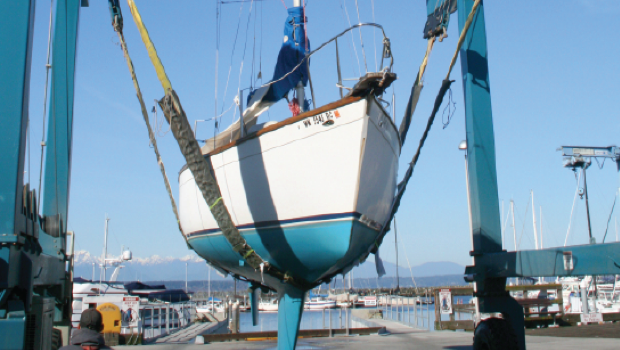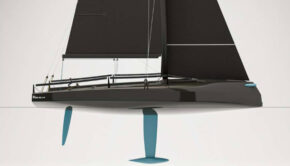Considerations for winter haul out
Published on November 12th, 2020
This time of year, every skipper should go through a “what-if” scenario when considering a specific place to haul out. In this report for Practical Sailor, editor Darrell Nicholson examines the concerns.
The “what-ifs” of where to store your boat for the winter include the potential impact of gale or storm-force winds, a significant tidal rise, and torrential rain.
Low-lying facilities exposed to the most volatile wind direction can spell trouble, as can a yard that’s notorious for catching rain water runoff that turns a hard pan surface into soupy muck – destabilizing the jack-stands that support the blocked-up boats.
During hurricane season, tidal surge presents the biggest concern there, but it is usually the vessels in the marina rather than those blocked up on land that suffer most. In winter, volatile storms can pack the punch of a tropical storm, so whether afloat or on dry land, a vessel needs to be able to endure the onslaught.
Frayed lifting slings, deteriorated pilings, and rusty machinery may still work, but more often than not, they are signs of the overall quality of workmanship that a boatyard has to offer. Those seeking lowest-cost options need to be especially aware of how their boat will be hauled and handled. When all is said and done, it’s hard to beat a new or well-maintained Travelift or hydraulic trailer. Equally important is the dock or ramp it operates on. But no matter how good the gear, the skill of the operator is the most important variable of all.
With sailboats, sling placement is crucial, and the geometry of the hull shape in conjunction with the cable lead adjustability on the lift will determine how equal the sling loading will be. Also critical is the cable angle, a factor that can lead to sling slippage, and in extreme cases, a vessel being dropped. A skilled operator will know how to handle various hull shapes and what rigging must be undone to fit a vessel into the confines of a Travelift’s web.
One bit of boatyard wisdom worth remembering: “Being told that yours is the biggest vessel ever hauled by the facility should not be confused with words of encouragement.”
Cranes up the ante for concern, and their operation requires extreme care, especially if they are used to transport a vessel once it is hoisted from the water. Bulkhead collapse, tire failure, and shifting ground can set the stage for disaster. Hauling via a Travelift, hydraulic trailer, and even the venerable marine railway are usually better options. Above all, if a crane is hauling your boat, be sure the operator uses “spreader bars,” a cage that keeps the sling load from compressing the hull.
Our tool of choice is a conventional Travelift that runs out onto a well-supported lift pier. Their setup is well protected from wind and sea. Ideally, the lift operator has decades of experience, and knows both the capacity of his lift and the challenges of any given vessel.
When it came time to haul PS test boat, an Ericson 41, the operator had us turn the boat around, release the backstay, and with runners set, he hauled the boat stern first. This was easier than removing a head stay and inner forestay, and allowed for better sling spacing. The efficient haul was followed by a thorough high-pressure wash down that removed all soft marine growth, leaving behind only a few tenacious barnacles at the bottom.
Standing up a vessel that’s designed to float can be a challenge. In many cases, the hull skin is too thin to take the heavy point loading associated with too few blocks under a keel or near overextended pads or jack stands.
Properly executed, the blocking and shoring process is a means of spreading contact loads and rigidly supporting a vessel in a vertical position. Sailboats with external ballast easily endure the pressure imposed by keel blocks but may be troubled by the hull weight pressing down and flexing the keel/hull joint. Many lightly built race boats are fitted to special cradles that spread loads to numerous large contact points and allow the keel to hang.
In gale-force conditions, some race boats stowed in such a fashion, especially those stored with their masts still stepped, have been known to develop a pendulum-like keel motion that can capsize the cradle-supported boat. Wedging the keel bulb to prevent such an oscillation makes sense.
In our case, the yard crew used plenty of timber blocks for keel support and cross chained screw-jack poppets to provide both athwart ship and fore and aft stability.
There is a subtle but significant difference between these three-legged stands. The ones with a narrower base are less stable and harder to use effectively. When supporting a sailboat with tripod-like jackstands, the idea is to extend an imaginary right-angle line from the hull skin to the ground at every pad point, and make the jackstands centerline axis coincide with this line.
The more it diverges, the more there’s a tendency to “kick out” a stand if the vessel starts oscillating in high winds. Chaining the stands together lessens this likelihood.
Once a boat has been shored and blocked, it is a good idea to layer tarps or plastic sheeting beneath it. That keeps cleaners, paint, paint removers, and other chemicals from contaminating the ground. Layering the tarps means you can remove a soiled one and have a clean surface to kneel or stand on.
For more than 35 years, Practical Sailor has been taking the guesswork out of boat and gear buying with bold, independent boat tests, and product-test reports for serious sailors and boaters. Practical Sailor does not accept any advertising. Our testing program is supported by loyal subscribers who believe in our mission and want to make the best choices when buying a boat, or equipping and maintaining the one they have. To learn more about Practical Sailor, click here.









 We’ll keep your information safe.
We’ll keep your information safe.